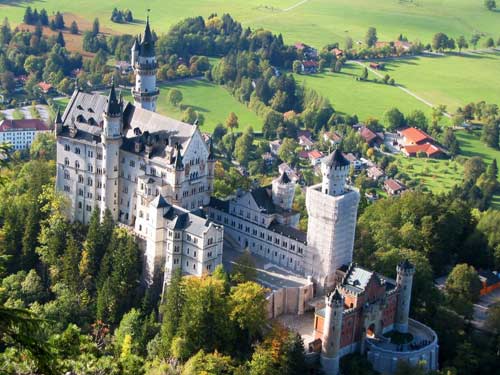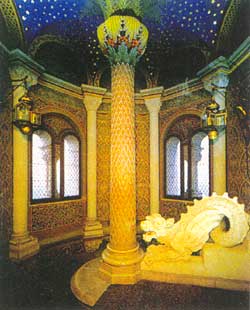- Construction Period: 1869 – 1886
- Location: The Alps, Bavaria, Germany
Neuschwanstein Castle, perched on a rugged cliff overlooking the forests at the foot of the Alps in Bavaria, is one of the most iconic and picturesque images in the world. What sets this castle apart from most others is that it was not built to flaunt power or wealth, but rather as a private residence for its owner, King Ludwig II, and a few close attendants.
 |
Neuschwanstein Castle rising high above the vertical cliff, a perfect blend of classical and Gothic architectural elements with a romantic design |
Ludwig’s father, Maximilian II, built the nearby Hohenschwangau Castle in 1837 as a summer residence. Styled in Gothic architecture, it was influenced by historical designs popular in the early 19th century. Ludwig grew up here, and it was in the music room that he was first introduced to composer Richard Wagner, whose operas left a lasting impression on the young prince.
 |
At the end of the staircase in the North Tower, a dragon statue bows to greet those who reach the top of the tower. Designed by successor Riedel – Julius Hofmann, this section was one of the last parts of the castle completed in 1884. |
Ludwig became king at 18 without any formal education, quickly finding himself at odds with the ministers in his government. Realizing he had no inclination or talent for politics, he increasingly distanced himself from daily reality, retreating into a world of legend and fantasy.
At that time, the construction site was littered with the rubble of a previous castle, and in a letter to Wagner dated 1868, Ludwig wrote: “I intend to build a castle in the true style of ancient German knights on the ruins of the old castle… here the divine will visit and dwell with us on the high, cool slope, with a gentle breeze from paradise.” The castle became a refuge where many heroes from Wagner’s musical dramas not only debuted on stage but also existed as archetypal figures.
Design and Style
The initial sketches for Neuschwanstein Castle were created by stage designer Christian Jank at the Court Theater in Munich in 1868, which were eventually adapted into feasible architectural plans by Edouard Riedel the following year. The site also posed significant challenges, as it is situated 200 meters above the existing roadway on a barren hillside. Eventually, a spring was discovered, and water was pumped up to the castle, which remains to this day. Riedel worked on the project until 1872, after which two other architects took over until the king’s vision was realized, although other interior sections remained unfinished.
The main style is a blend of 13th-century German Gothic and classical architecture, though interpreted loosely. Some features were inspired by existing structures, but overall, it is a unique composition—with the castle’s unusually tall towers and conical roofs creating an unforgettable impression amidst the surrounding forests and distant mountains. Interestingly, at night, the king would ascend a bridge on the northern side to enjoy the sight of the castle lit by hanging lanterns and countless shimmering candles, reminiscent of a fairy tale.
The exterior of the castle also impresses with a variety of elements and massive stone walls softened by intricate decorative details. As a result, visitors are often unprepared for the richness and complexity of the interior decor schemes—it’s hard to find any surface without some form of artistic ornamentation. Ludwig’s bedroom is particularly opulent, achieving a striking effect through Gothic style, featuring intricately carved oak panels and paintings by A. Spiess illustrating the legend of Tristan and Isolde. The living room is inspired by the myth of Lohengrin, the Knight of the Swan (Neuschwanstein translates to “New Stone Swan“) as depicted by Hauschild in the tapestry.
 |
The Throne Room, inspired by Ludwig’s vision of the Hagia Sophia, designed by Edouard, originally intended to be the Holy Grail Room in Wagner’s Parsifal. (Photo: puzzlehouse) |
The two largest rooms in the castle are the Throne Room and the Singer’s Hall. The Throne Room features elaborate Byzantine arches surrounding it, yet unfortunately, the throne itself, meant to be the focal point of the room, was never completed. The Singer’s Hall, inspired by the original in Wartburg, has a raised ceiling adorned with numerous panels filled with decorative motifs representing astrological signs. These rooms allow Ludwig to escape historical roles like Lohengrin, amidst a landscape where “imagination is the model to create reality”—later, Walt Disney would depict the castle from the north as the symbol of Disneyland.
Factual Figures:
- Area: 5,935 m2
- Height: 965 m
- Number of completed rooms (out of 228 planned): 15
- Cost (at the time of Ludwig’s death): 6,180,047 marks
Unfortunately, Ludwig’s story did not have a happy ending. In 1880, the annual cost to complete the castle was estimated at around 900,000 marks, with completion aimed for 1893. By this time, Ludwig had commenced the construction of two other castles, and the simultaneous demands of building three castles exceeded his financial capacity, as he had to fund construction from a treasure grant for a king rather than from the public purse. This likely contributed to the perception of him as an endearing eccentric by his subjects, while his government increasingly disapproved of his obvious delusions, eventually orchestrating for a committee of mental health professionals (who never actually examined Ludwig) to declare the king insane, appointing his 60-year-old uncle as regent.
 |
The Singer’s Hall inspired by the original in Wartburg, which in turn inspired Wagner’s Tannhäuser (Photo: rainfall) |
Ludwig was deeply distressed, ultimately forced to abdicate and was exiled from Neuschwanstein Castle. Three days later, on June 13, 1886, he was found drowned along with his physician in Lake Starnberg. Contrary to the king’s wishes, the castle opened to the public three weeks after his death, creating a lasting irony for Ludwig—the king who preferred privacy above all else became the centerpiece of one of Germany’s top tourist attractions.




















































